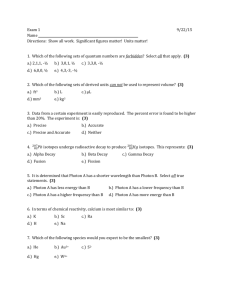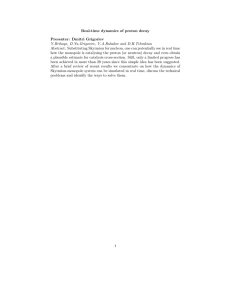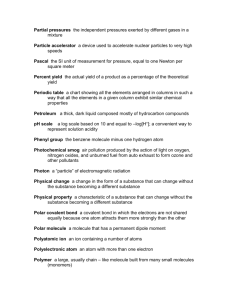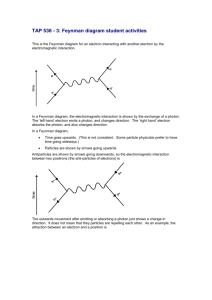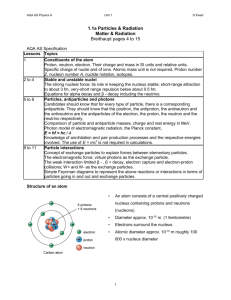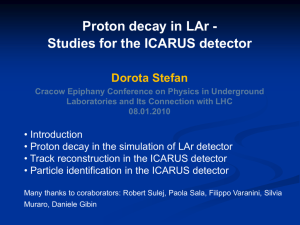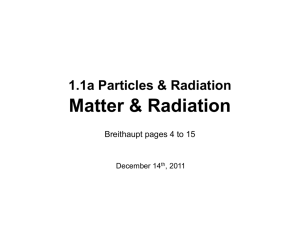Particles & Quantum Phenomena Questions
advertisement
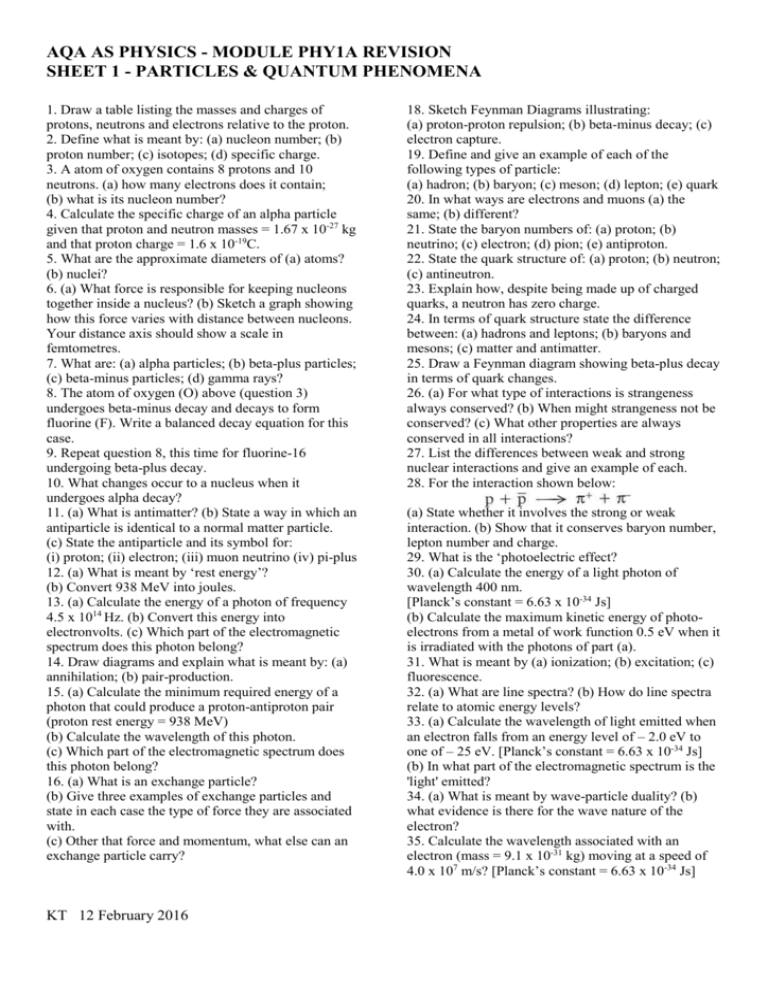
AQA AS PHYSICS - MODULE PHY1A REVISION SHEET 1 - PARTICLES & QUANTUM PHENOMENA 1. Draw a table listing the masses and charges of protons, neutrons and electrons relative to the proton. 2. Define what is meant by: (a) nucleon number; (b) proton number; (c) isotopes; (d) specific charge. 3. A atom of oxygen contains 8 protons and 10 neutrons. (a) how many electrons does it contain; (b) what is its nucleon number? 4. Calculate the specific charge of an alpha particle given that proton and neutron masses = 1.67 x 10-27 kg and that proton charge = 1.6 x 10-19C. 5. What are the approximate diameters of (a) atoms? (b) nuclei? 6. (a) What force is responsible for keeping nucleons together inside a nucleus? (b) Sketch a graph showing how this force varies with distance between nucleons. Your distance axis should show a scale in femtometres. 7. What are: (a) alpha particles; (b) beta-plus particles; (c) beta-minus particles; (d) gamma rays? 8. The atom of oxygen (O) above (question 3) undergoes beta-minus decay and decays to form fluorine (F). Write a balanced decay equation for this case. 9. Repeat question 8, this time for fluorine-16 undergoing beta-plus decay. 10. What changes occur to a nucleus when it undergoes alpha decay? 11. (a) What is antimatter? (b) State a way in which an antiparticle is identical to a normal matter particle. (c) State the antiparticle and its symbol for: (i) proton; (ii) electron; (iii) muon neutrino (iv) pi-plus 12. (a) What is meant by ‘rest energy’? (b) Convert 938 MeV into joules. 13. (a) Calculate the energy of a photon of frequency 4.5 x 1014 Hz. (b) Convert this energy into electronvolts. (c) Which part of the electromagnetic spectrum does this photon belong? 14. Draw diagrams and explain what is meant by: (a) annihilation; (b) pair-production. 15. (a) Calculate the minimum required energy of a photon that could produce a proton-antiproton pair (proton rest energy = 938 MeV) (b) Calculate the wavelength of this photon. (c) Which part of the electromagnetic spectrum does this photon belong? 16. (a) What is an exchange particle? (b) Give three examples of exchange particles and state in each case the type of force they are associated with. (c) Other that force and momentum, what else can an exchange particle carry? KT 12 February 2016 18. Sketch Feynman Diagrams illustrating: (a) proton-proton repulsion; (b) beta-minus decay; (c) electron capture. 19. Define and give an example of each of the following types of particle: (a) hadron; (b) baryon; (c) meson; (d) lepton; (e) quark 20. In what ways are electrons and muons (a) the same; (b) different? 21. State the baryon numbers of: (a) proton; (b) neutrino; (c) electron; (d) pion; (e) antiproton. 22. State the quark structure of: (a) proton; (b) neutron; (c) antineutron. 23. Explain how, despite being made up of charged quarks, a neutron has zero charge. 24. In terms of quark structure state the difference between: (a) hadrons and leptons; (b) baryons and mesons; (c) matter and antimatter. 25. Draw a Feynman diagram showing beta-plus decay in terms of quark changes. 26. (a) For what type of interactions is strangeness always conserved? (b) When might strangeness not be conserved? (c) What other properties are always conserved in all interactions? 27. List the differences between weak and strong nuclear interactions and give an example of each. 28. For the interaction shown below: (a) State whether it involves the strong or weak interaction. (b) Show that it conserves baryon number, lepton number and charge. 29. What is the ‘photoelectric effect? 30. (a) Calculate the energy of a light photon of wavelength 400 nm. [Planck’s constant = 6.63 x 10-34 Js] (b) Calculate the maximum kinetic energy of photoelectrons from a metal of work function 0.5 eV when it is irradiated with the photons of part (a). 31. What is meant by (a) ionization; (b) excitation; (c) fluorescence. 32. (a) What are line spectra? (b) How do line spectra relate to atomic energy levels? 33. (a) Calculate the wavelength of light emitted when an electron falls from an energy level of – 2.0 eV to one of – 25 eV. [Planck’s constant = 6.63 x 10-34 Js] (b) In what part of the electromagnetic spectrum is the 'light' emitted? 34. (a) What is meant by wave-particle duality? (b) what evidence is there for the wave nature of the electron? 35. Calculate the wavelength associated with an electron (mass = 9.1 x 10-31 kg) moving at a speed of 4.0 x 107 m/s? [Planck’s constant = 6.63 x 10-34 Js]
